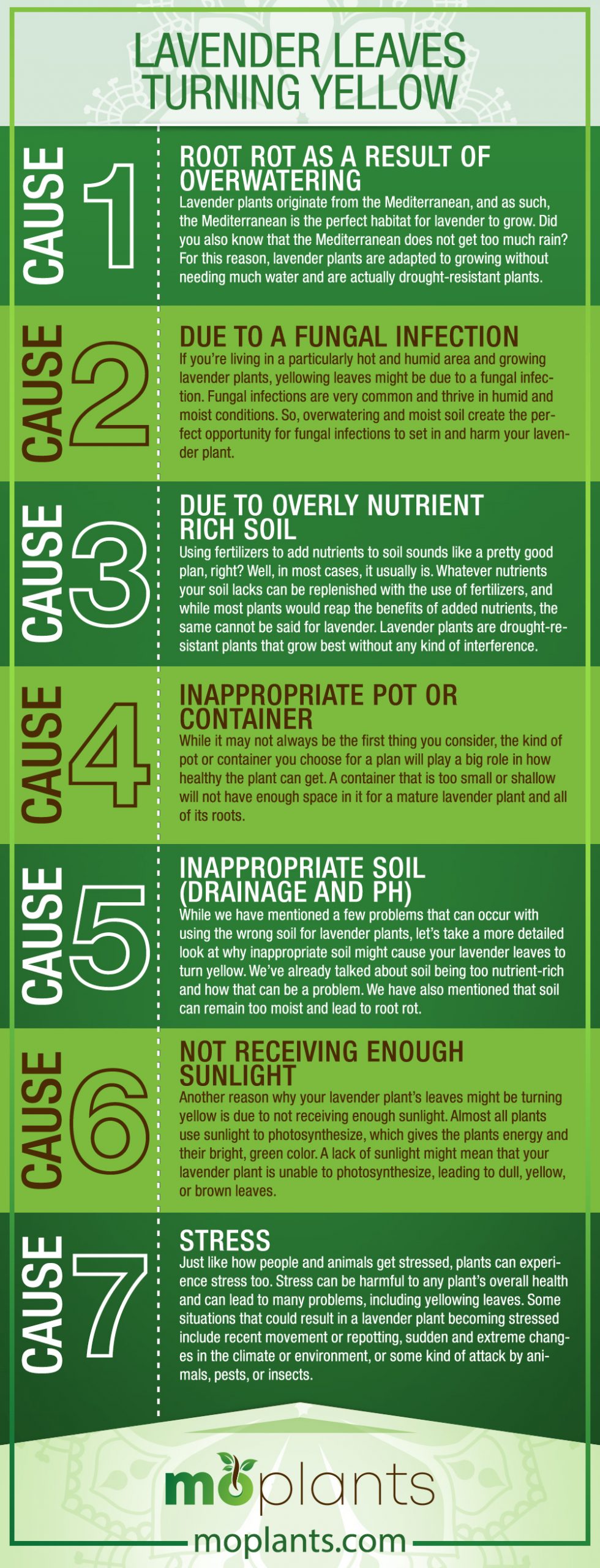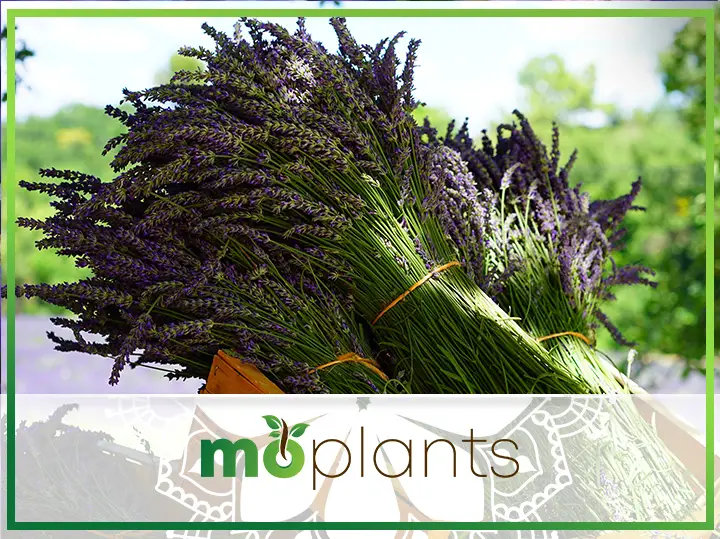When we think of lavender plants, we imagine bright purple flowers and long, bright green leaves. The next thing that comes to mind is the soothing, refreshing, and comfortable scent the plant exudes. Whether you keep lavender in the house to use as an herb in cooking, making essential oils, or simply because you find the plant beautiful, there is very little use for it if it is not healthy.
Sadly, it is very common to find the leaves on a lavender plant turning yellow and drooping. Lavender is usually easy to grow and take care of if it is kept in the right conditions. In case something is wrong, the plant lets you know by coloring its leaves.
So why, exactly, do lavender leaves start turning yellow? There are about seven causes that you could consider, ranging from root rot and fungal infections to inappropriate soil and overly nutrient-rich soil. If you can correctly determine why your lavender plant’s leaves turn yellow, you can overcome the problem and get your plant back to its healthy condition.
Read ahead for all of the seven causes for why lavender leaves turn yellow and what can be done to prevent this from happening.
Cause 1: Root Rot as A Result of Overwatering
Lavender plants originate from the Mediterranean, and as such, the Mediterranean is the perfect habitat for lavender to grow. Did you also know that the Mediterranean does not get too much rain? For this reason, lavender plants are adapted to growing without needing much water and are actually drought-resistant plants. Therefore, overwatering can cause the plant’s roots to start to rot. Yellowing leaves are a big sign of root rot. Generally, a lavender plant needs to be watered once every two or three weeks. The soil should dry out between watering, and the soil should not remain moist all the time.
If you think your lavender plant has been overwatered and is suffering from root rot, we have the solution for you. You need to take the plant out of the pot, trim off any rotten roots, and then transfer your plant into a new pot with fresh soil. The new soil should be dry and sandy so that the roots have time to dry out as well. After a week or two in the new soil, you can water the plant. Also, remember that the pot you use has drainage holes, so the soil does not retain too much moisture.
It is important to keep in mind that lavender plants do not necessarily always recover from root rot and can sometimes die out completely. However, if you catch it early, remove all the rotten roots, and leave behind enough healthy roots, your chances of your lavender plant recovering are much higher.
Cause 2: Due to A Fungal Infection
If you’re living in a particularly hot and humid area and growing lavender plants, yellowing leaves might be due to a fungal infection. Fungal infections are very common and thrive in humid and moist conditions. So, overwatering and moist soil create the perfect opportunity for fungal infections to set in and harm your lavender plant. While yellowing leaves may not seem too concerning, and you might opt to just trim off those leaves, a fungal infection left untreated can eventually result in lesions on the roots of the plant. The whole lavender plant will likely die when the roots suffer too much.
The way to prevent fungal infections in your lavender plants is by creating the right conditions for the plant to flourish. This means sticking to a watering schedule, leaving the plant in sunlight so that the soil does not remain moist, using well-drained soil, and pruning out infected parts. Since fungal spores can be spread through the air or by insects, keep the infected plant away from other plants to reduce the spread of the infection. And finally, visit your local nursery to find a suitable fungicide for your lavender plant. Be sure to follow the instructions carefully when using the fungicide.
Cause 3: Due to Overly Nutrient Rich Soil
Using fertilizers to add nutrients to soil sounds like a pretty good plan, right? Well, in most cases, it usually is. Whatever nutrients your soil lacks can be replenished with the use of fertilizers, and while most plants would reap the benefits of added nutrients, the same cannot be said for lavender. Lavender plants are drought-resistant plants that grow best without any kind of interference. Once they have matured, they must mostly be left alone except for being watered once every two or three weeks. So, adding fertilizer to your lavender plant might do more harm than good.
Lavender plants are especially sensitive to nitrogen. Because the plant has adapted to grow in poor-quality soil, it cannot handle added nitrogen, which actually results in the yellowing of the leaves. If there is too much nitrogen in the soil, you will also notice much more foliage in your plant than flowers.
If you have used fertilizer or suspect that the soil might be overly nutrient-rich, there is an easy fix to this problem. You simply need to repot your plant into the new soil. We suggest you use grit or horticultural sand and stay away from fertilizers for the sake of your lavender having bright green foliage and plenty of blooms.
Cause 4: Inappropriate Pot or Container
While it may not always be the first thing you consider, the kind of pot or container you choose for a plan will play a big role in how healthy the plant can get. A container that is too small or shallow will not have enough space in it for a mature lavender plant and all of its roots. If the roots of the lavender plant are being constricted or squished, they won’t be able to carry water and nutrients to the rest of the plant, which can result in yellowing leaves.
Alternatively, the pot or container you choose could be a perfect size, but it might not have drainage holes. Drainage holes are incredibly important in allowing excess water to drain out of the soil. While some plants might be able to survive in pots without drainage holes, lavender plants are particularly sensitive to excess water since they are drought-resistant plants. So, if there are no drainage holes, the soil can become overly moist and might not dry out completely between watering sessions. This can definitely result in lavender leaves turning yellow.
The way to fix this problem is quite simple. All you need to do is find a more appropriate pot or container and repot your lavender plant into it. The pot should be the appropriate size – keep in mind width and depth. It should also have enough drainage holes. You can also make more drainage holes using a drill, a nail, and a hammer. It might take a bit of practice to get the skill down without the risk of cracking your pot. If you don’t want to use ceramic or plastic containers, terracotta and clay are also a very good idea since both terracotta and clay are porous and allow the soil to dry out.
Cause 5: Inappropriate Soil (drainage and pH)
While we have mentioned a few problems that can occur with using the wrong soil for lavender plants, let’s take a more detailed look at why inappropriate soil might cause your lavender leaves to turn yellow. We’ve already talked about soil being too nutrient-rich and how that can be a problem. We have also mentioned that soil can remain too moist and lead to root rot.
The other things you need to consider when choosing the right soil for your lavender plant are the soil’s drainage capabilities and pH levels. When it comes to drainage, you need to mix together soil that will dry out well between watering sessions. Such soil would have a good portion of sand, grit, gravel, or horticulture sand in it. These kinds of sands are very porous and do not retain water. By allowing the water to pass through, the sand remains dry enough to help the lavender grow and stay healthy.
As for the pH levels of the soil, you want to avoid acidic pH levels soils. The best pH level for lavender plants is between 6.5 to 7.5. You can test your plant’s soil, and if it is too acidic, you can add lime or wood ash to it to make it more basic. Overall, if you think that your lavender plant’s leaves are turning yellow due to inappropriate soil, you should either change the soil out or try to adjust its pH level.
Cause 6: Not Receiving Enough Sunlight
Another reason why your lavender plant’s leaves might be turning yellow is due to not receiving enough sunlight. Almost all plants use sunlight to photosynthesize, which gives the plants energy and their bright, green color. A lack of sunlight might mean that your lavender plant is unable to photosynthesize, leading to dull, yellow, or brown leaves.
In an ideal situation, your lavender plant should get between six or seven hours of sunlight every day. You might have placed the plant in an area where it gets indirect light, weak light, or even little to no light if some other object is blocking it.
The solution to this problem is relatively easy. You can change your lavender plant’s place in the house and keep it near a window or even outside in the garden. If no one spot in your house gets sunlight throughout the entire day, you can also change the plant’s place multiple times a day to different sunny spots. In case your lavender plant is growing in the ground, consider trimming the plants around it that might be blocking its light. You could also consider investing in a grow light that can replace natural sunlight.
Cause 7: Stress
And last but not least, another reason for your lavender leaves turning yellow could be due to stress. Just like how people and animals get stressed, plants can experience stress too. Stress can be harmful to any plant’s overall health and can lead to many problems, including yellowing leaves. Some situations that could result in a lavender plant becoming stressed include recent movement or repotting, sudden and extreme changes in the climate or environment, or some kind of attack by animals, pests, or insects.
If you think stress is why your lavender leaves are yellowing, the problem might resolve itself in a week or two when the plant adjusts to its new pot or the different environment. As for being attacked by pests and animals, consider changing where the plant is kept or putting up a fence or barrier. If the plant is suffering due to a change in climate, bringing it indoors might help the situation.
Infographic

The Bottom Line
Lavender plants are drought-resistant plants that do well in dry and sunny conditions. If completely healthy, the plant should have bright green foliage and lots of purple flowers. Yellowing leaves are a sure sign that something is wrong. We have outlined some of the main reasons why your lavender plant’s leaves might be turning yellow and all of the appropriate solutions, too. Hopefully, now you’ll be able to make the necessary changes to ensure your lavender plant becomes happy and healthy once again.


